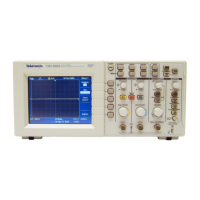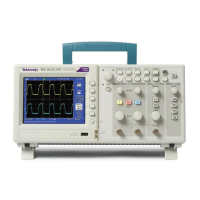Command Syntax
2−6
TDS200/1000/2000 Series Oscilloscope Programmer Manual
Concatenating Commands
You can concatenate any combination of set commands and queries
using a semicolon (;). The oscilloscope executes concatenated
commands in the order received. When concatenating commands
and queries you must follow these rules:
H Completely different headers must be separated by both a
semicolon and by the beginning colon on all commands but the
first. For example, the commands TRIGger:MODe NORMal and
ACQuire:NUMAVg 16 can be concatenated into a single
command:
TRIGger:MODe NORMal;:ACQuire:NUMAVg 16
H If concatenated commands have headers that differ by only the
last mnemonic, you can abbreviate the second command and
eliminate the beginning colon. For example, the commands
ACQuire:MODe AVErage and ACQuire:NUMAVg 16 could be
concatenated into a single command:
ACQuire:MODe AVErage; NUMAVg 16
The longer version works equally well:
ACQuire:MODe AVErage;:ACQuire:NUMAVg 16
H Never precede a star (*) command with a colon:
ACQuire:MODe AVErage;*TRG
The oscilloscope processes commands that follow the star
command as if the star command was not there, so:
ACQuire:MODe AVErage;*TRG;NUMAVg 16
sets the acquisition mode to average and sets acquisition
averaging to 16. The *TRG command is ignored.

